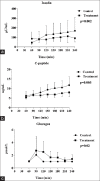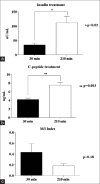The Impact of Dopamine on Insulin Secretion in Healthy Controls
- PMID: 29743758
- PMCID: PMC5930523
- DOI: 10.4103/ijccm.IJCCM_175_17
The Impact of Dopamine on Insulin Secretion in Healthy Controls
Abstract
Objective: Dopamine is very commonly used in the critical care setting and impacts glucose homeostasis. In some studies, it is noted to increase insulin resistance or decrease insulin secretion. The role of insulin secretion in response to dopamine is incompletely understood.
Methods: Eight individuals underwent a hyperglycemic clamp with a dopamine infusion, and eight controls underwent hyperglycemic clamp alone. Insulin, C-peptide, glucagon, cortisol, and norepinephrine (NE) concentrations were measured at various time points. An index of insulin sensitivity (M/I) was calculated. Statistical comparison between the control and treatment arm was done using repeated measures ANOVA. The data is expressed as mean ± standard deviation. Paired t-test was used to compare pre- and post-dopamine infusion time points in the study individuals only. Data was considered to be statistically significant at P < 0.05.
Results: On assessing the treatment group before and during dopamine infusion, insulin and C-peptide concentrations were higher at the time of the infusion (P = 0.02 and P = 0.003, respectively). The index of insulin sensitivity was not statistically different. There was a significant decrease in insulin (P = 0.002), C-peptide (P = 0.005), and NE (P < 0.0001) concentrations in the treatment group, compared to the controls. Glucagon concentration was higher in the treatment group (P = 0.02).
Conclusion: In this study, dopamine infusion did not adversely impact insulin secretion.
Keywords: Dopamine; glucose; hyperglycemia; insulin sensitivity; pressors.
Conflict of interest statement
There are no conflicts of interest.
Figures



References
-
- Shankar E, Santhosh KT, Paulose CS. Dopaminergic regulation of glucose-induced insulin secretion through dopamine D2 receptors in the pancreatic islets in vitro . IUBMB Life. 2006;58:157–63. - PubMed
-
- Rubí B, Ljubicic S, Pournourmohammadi S, Carobbio S, Armanet M, Bartley C, et al. Dopamine D2-like receptors are expressed in pancreatic beta cells and mediate inhibition of insulin secretion. J Biol Chem. 2005;280:36824–32. - PubMed
-
- García-Tornadú I, Ornstein AM, Chamson-Reig A, Wheeler MB, Hill DJ, Arany E, et al. Disruption of the dopamine d2 receptor impairs insulin secretion and causes glucose intolerance. Endocrinology. 2010;151:1441–50. - PubMed
-
- Contreras F, Foullioux C, Pacheco B, Maroun C, Bolívar H, Lares M, et al. Effect of drugs interacting with the dopaminergic receptors on glucose levels and insulin release in healthy and type 2 diabetic subjects. Am J Ther. 2008;15:397–402. - PubMed
Grants and funding
LinkOut - more resources
Full Text Sources
Other Literature Sources
